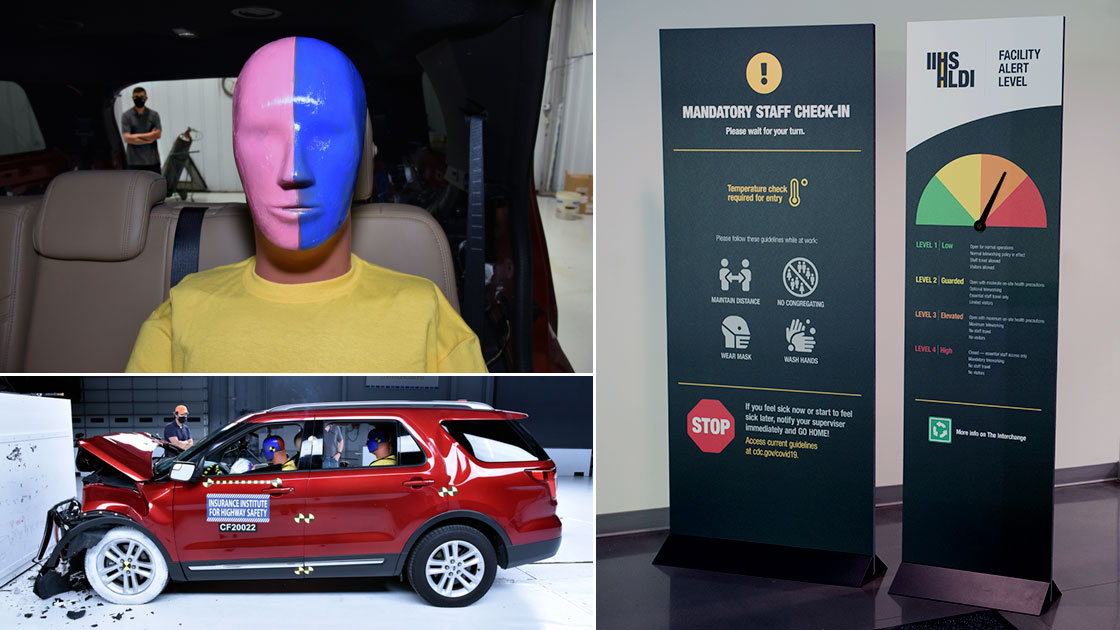With health precautions in place, testing resumes at Vehicle Research Center
July 1, 2020

Employees have returned to the Insurance Institute for Highway Safety's Vehicle Research Center (VRC) on a limited basis, resuming work that had to be paused amid the Covid-19 pandemic.
IIHS closed both the VRC, located in Ruckersville, Virginia, and its Arlington, Virginia, office in March, as the state was shutting down. Much of the Institute’s work continued, with employees working from home, but crash tests and track evaluations had to be paused.
Virginia began a phased reopening in May. In addition to adhering to state guidelines, IIHS has applied supplemental criteria to ensure that the health situation in the immediate area around the VRC was improving before attempting to reopen the facility. The Arlington office remains closed.
On June 15, a skeleton crew returned to work at the VRC and that week conducted the first crash test there since March. The test involved a Chrysler Pacifica minivan striking a rigid wall at 35 mph. The demonstration will be used to update some of the Institute’s educational videos. The driver dummy and two child dummies were unbelted.
“We’re following the same rigorous protocols as we always do for our crash tests, plus some important new ones,” says IIHS Chief Administrative Officer Joe Nolan. “The only employees around for the crash tests are those who absolutely need to be there, and, of course, there are no visitors observing the action.”
In addition to crash testing, evaluations of headlights and front crash prevention systems — both vehicle-to-vehicle and vehicle-to-pedestrian — have also resumed. One employee drives each car in all of those tests in order to avoid the need to sanitize it between tests.
For now, VRC employees who can telework are continuing to do so. Those needed for on-site work are split into two teams working alternating weeks.
Everyone at the VRC must wear masks unless they are in an office or vehicle by themselves and must adhere to a rigorous cleaning protocol. If employees need to get within six feet of each other, they must also wear face shields.
All vehicles delivered to the VRC, whether borrowed or purchased, are parked and not touched for two days.
If a vehicle is needed sooner, it can be sanitized by raising the temperature inside to 130 degrees Fahrenheit for 20 minutes or 150 degrees for 5 minutes to bypass the two-day isolation period. The method is based on a system that Ford recently developed for police to use with its cruisers. While Ford has special software for the process, IIHS simply uses sunlight and the vehicle’s climate control system (plus auxiliary heaters if needed) to raise the temperatures to the specified sanitization levels.
Inside the building, HVAC settings have been changed to increase fresh air intake, and HEPA filters have been installed in certain closed-off areas. In the crash hall and other areas, doors are opened and exhaust fans are being run regularly.
“These new procedures are enabling us to safely get back to our important testing and safety research,” Nolan says. “We are grateful to our employees for their flexibility and diligence as we work through these new challenges.”
Even as crash testing was paused, VRC staff have been able to continue publishing the safety ratings that consumers rely on. Many ratings in long-established tests are based on crashes that are conducted by manufacturers. While telecommuting, employees involved in this process have been reviewing documentation and video just as they would in the office. More than 30 such verification ratings have been completed since the facility shut down.
Still, the monthslong closure of the VRC has forced some changes to the Institute’s plans for its ratings programs.
Before the pandemic, IIHS had informed automakers that it was developing an evaluation of rear-passenger protection in frontal crashes, an updated side crash test and a seat-belt reminder rating. Those new evaluations were supposed to be added to the Institute’s awards criteria for 2022. The target year for those changes to the awards program has now been changed to 2023, and the Top Safety Pick and Top Safety Pick+ criteria for 2022 will remain the same as for 2021 and 2020.
This additional time will also make it more realistic for automakers to achieve the higher standards. Manufacturers have seen pandemic-related disruptions to their supply chains and manufacturing, as well as to their own testing capabilities.